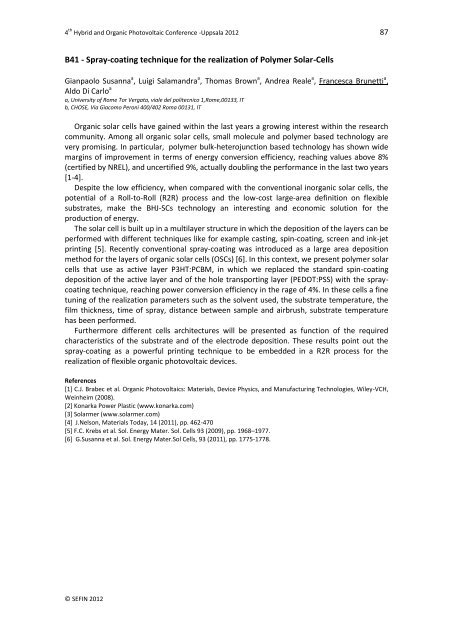HOPV12 - Blogs
HOPV12 - Blogs
HOPV12 - Blogs
You also want an ePaper? Increase the reach of your titles
YUMPU automatically turns print PDFs into web optimized ePapers that Google loves.
4 th Hybrid and Organic Photovoltaic Conference -Uppsala 2012 87<br />
B41 - Spray-coating technique for the realization of Polymer Solar-Cells<br />
Gianpaolo Susanna a , Luigi Salamandra a , Thomas Brown a , Andrea Reale a , Francesca Brunetti a ,<br />
Aldo Di Carlo a<br />
a, University of Rome Tor Vergata, viale del politecnico 1,Rome,00133, IT<br />
b, CHOSE, Via Giacomo Peroni 400/402 Roma 00131, IT<br />
Organic solar cells have gained within the last years a growing interest within the research<br />
community. Among all organic solar cells, small molecule and polymer based technology are<br />
very promising. In particular, polymer bulk-heterojunction based technology has shown wide<br />
margins of improvement in terms of energy conversion efficiency, reaching values above 8%<br />
(certified by NREL), and uncertified 9%, actually doubling the performance in the last two years<br />
[1-4].<br />
Despite the low efficiency, when compared with the conventional inorganic solar cells, the<br />
potential of a Roll-to-Roll (R2R) process and the low-cost large-area definition on flexible<br />
substrates, make the BHJ-SCs technology an interesting and economic solution for the<br />
production of energy.<br />
The solar cell is built up in a multilayer structure in which the deposition of the layers can be<br />
performed with different techniques like for example casting, spin-coating, screen and ink-jet<br />
printing [5]. Recently conventional spray-coating was introduced as a large area deposition<br />
method for the layers of organic solar cells (OSCs) [6]. In this context, we present polymer solar<br />
cells that use as active layer P3HT:PCBM, in which we replaced the standard spin-coating<br />
deposition of the active layer and of the hole transporting layer (PEDOT:PSS) with the spraycoating<br />
technique, reaching power conversion efficiency in the rage of 4%. In these cells a fine<br />
tuning of the realization parameters such as the solvent used, the substrate temperature, the<br />
film thickness, time of spray, distance between sample and airbrush, substrate temperature<br />
has been performed.<br />
Furthermore different cells architectures will be presented as function of the required<br />
characteristics of the substrate and of the electrode deposition. These results point out the<br />
spray-coating as a powerful printing technique to be embedded in a R2R process for the<br />
realization of flexible organic photovoltaic devices.<br />
References<br />
[1] C.J. Brabec et al. Organic Photovoltaics: Materials, Device Physics, and Manufacturing Technologies, Wiley-VCH,<br />
Weinheim (2008).<br />
[2] Konarka Power Plastic (www.konarka.com)<br />
[3] Solarmer (www.solarmer.com)<br />
[4] J.Nelson, Materials Today, 14 (2011), pp. 462-470<br />
[5] F.C. Krebs et al. Sol. Energy Mater. Sol. Cells 93 (2009), pp. 1968–1977.<br />
[6] G.Susanna et al. Sol. Energy Mater.Sol Cells, 93 (2011), pp. 1775-1778.<br />
© SEFIN 2012


